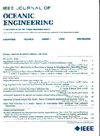Design and Development of a Low-Cost Floater for Sustainable Fishing
IF 5.3
2区 工程技术
Q1 ENGINEERING, CIVIL
引用次数: 0
Abstract
While it is widely recognized that fish are an ecologically and commercially important group, our current knowledge of fish occurrence, composition (diversity), abundance and behavior (e.g., migration) is limited to anecdotal sightings and reports, often from laypersons. In situ marine monitoring bridges this gap and allows us to track and monitor marine life. One such system is the SOUND system: a swarm of low-cost Lagrangian floats that can noninvasively support aquaculture and fisheries, especially in remote areas and developing countries. The swarm of floats works together in a group and uses underwater acoustic communication. It provides long-term data on the fish population, which can shed light on the interdependencies of spatially segmented ecosystems, the top-down regulation of bio-geophysical processes and the sensitivity of the environment to anthropogenic stress factors. SOUND Floater consists of a piston-based buoy control system, an active sonar system with on-board analysis and a satellite communication module. It is capable of probing the water to a depth of 50 m while maintaining position with an accuracy of可持续捕鱼低成本漂浮器的设计与开发
虽然人们普遍认识到鱼类是一个生态和商业上重要的群体,但我们目前对鱼类的发生、组成(多样性)、丰度和行为(例如迁徙)的了解仅限于轶事目击和报告,通常来自外行人。就地海洋监测弥补了这一差距,使我们能够跟踪和监测海洋生物。其中一个系统是SOUND系统:一群低成本的拉格朗日浮标,可以无创地支持水产养殖和渔业,特别是在偏远地区和发展中国家。这群漂浮物协同工作,利用水声通信。它提供了鱼类种群的长期数据,可以揭示空间分割生态系统的相互依赖性,生物地球物理过程的自上而下调节以及环境对人为压力因素的敏感性。SOUND浮子由一个活塞式浮筒控制系统、一个带有机载分析的主动声呐系统和一个卫星通信模块组成。它能够探测50米深的水,同时保持位置,精度为$<;$10 cm,探测距离500米的鱼群,连续工作5天。在这篇技术交流文章中,我们介绍了SOUND原型的详细设计,包括其机械、电气和算法部分。我们报告了实验室池和两次海上试验的结果。
本文章由计算机程序翻译,如有差异,请以英文原文为准。
求助全文
约1分钟内获得全文
求助全文
来源期刊

IEEE Journal of Oceanic Engineering
工程技术-工程:大洋
CiteScore
9.60
自引率
12.20%
发文量
86
审稿时长
12 months
期刊介绍:
The IEEE Journal of Oceanic Engineering (ISSN 0364-9059) is the online-only quarterly publication of the IEEE Oceanic Engineering Society (IEEE OES). The scope of the Journal is the field of interest of the IEEE OES, which encompasses all aspects of science, engineering, and technology that address research, development, and operations pertaining to all bodies of water. This includes the creation of new capabilities and technologies from concept design through prototypes, testing, and operational systems to sense, explore, understand, develop, use, and responsibly manage natural resources.
 求助内容:
求助内容: 应助结果提醒方式:
应助结果提醒方式:


